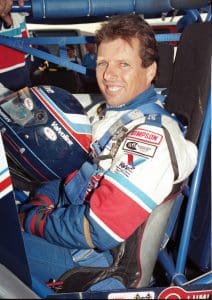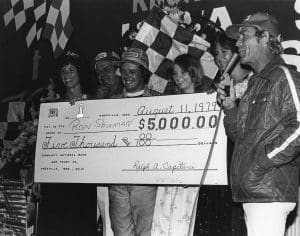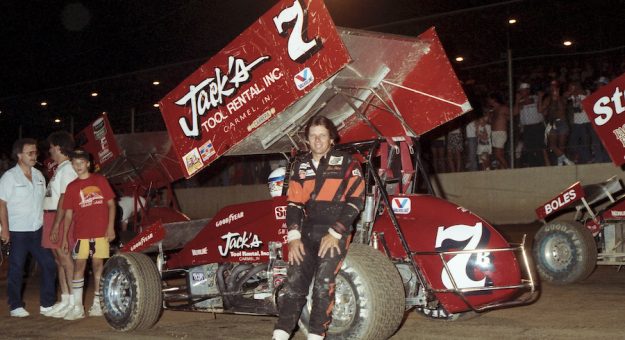Editor’s Note: This is the second and final installment of the SPEED SPORT Insider’s extended-length feature on open-wheel racer Ron Shuman.
At the end of the 1987 campaign, Ron Shuman found victory lane with CRA in Ed Ulyate’s famous Three Day Blinds sprint car. More importantly, he enjoyed himself.
“The whole time Ulyate is asking me what it is going to take to keep me next year and I thought man, it is fun to win races again. I ran second to Kinser 13 times in 1987 and I was tired of running second to that guy,” Shuman said. “Ed asked me how much money I made last year and I told him I should make 80 grand, but I probably only made 60.
“Then, he asked me how much I would make with his cars in the CRA, so I told him. He asked if he would give me a salary to make up for the rest if I would be willing to race for him,” Shuman continued. “I said, ‘Yes.’ So we started out that year running with a wing on Friday night and then we would go to Ascot on Saturday and run without a wing. That was fun.”
It worked out nicely. Shuman was leading the CRA points when he received an offer that was difficult to refuse.
“A guy in Australia wanted to pay me 10 grand to come down and race one weekend,” Shuman related. “So I talked to Ed and told him they were willing to pay me more than I would get for winning the CRA championship, and if I go down there, I will probably still be leading the points when I get back.”
Things went well down under, highlighted by sprint car and midget wins on the same night. Better yet, as Shuman predicted, he returned home and claimed the CRA title.
Then came a curveball. Ulyate thanked Shuman for a wonderful year and announced he was packing up and heading to Florida.
Shuman went ride hunting and landed in the famed Morales Tamale Wagon.

“I called him and said, ‘Andy (Morales), you have a great race car and all you need is a driver. I can win races and a championship. We don’t have to like each other so it can be strictly a business decision,’” Shuman explained. “He had to think about it awhile, but they hired me. About six months later he said that after he got to know me, he found out I was nothing like he thought I would be.”
What Morales got in the bargain was three straight titles.
In 1992 and ’93, Shuman raced for Billy Wilkerson and visited victory lane often. It was a perfect marriage. Wilkerson was not interested in racing the full slate and Shuman wanted freedom to do other things.
One of the things he loved to do was race in the Silver Crown Series. In 1992, he arrived for the Hoosier Hundred at the Indiana State Fairgrounds with Fred Ede’s M&L Plumbing team. What followed was one of the greatest races in Silver Crown history.
Fans were treated to a terrific three-way battle among Shuman, Jeff Swindell and title contender Steve Butler. Going into the third turn on the last lap Butler tried a bonsai move and tangled with Shuman. Shuman broke free and earned his greatest Silver Crown triumph.
In 1993, he held the points lead entering the Silver Crown season finale at the California State Fairgrounds in Sacramento. It was heartbreaking to fall short. Even more so because he places the blame squarely on his shoulders.
“I was on the pole and Jimmy Sills was on the front row and we are lapping Leroy van Connett about every four or five laps,” Shuman recalled. “He was that slow, but we were having a hell of a time getting around him because he was in the good part of the race track.
“Here I think I am so good in 100-lap races, but I burned a right-rear tire off trying to get around Sills. I pulled in to change the tire under yellow because there weren’t that many cars left,” Shuman continued. “Then, the guy with the air wrench has it going in the wrong direction and we can’t get the wheel off. So now I have to go out and run the last 10 or 12 laps very slowly. In my mind I was going to finish the race and win the championship by two points. Then, I was told I jumped a start and Mike Bliss won the championship by two points. Still, I blame myself because I should have never run so hard early in the race.”
On the sprint car side of the equation, CRA folded four races into the 1994 season and the Sprint Car Racing Ass’n was born.
Shuman began his year with a preliminary night win at the Chili Bowl Nationals before turning his attention back to sprint cars. He was a force to contend with and notched 13 SCRA victories en route to winning the series title.
He moved to Skip Schuck’s team and added championships in 1996 and ’97. His last title came in dramatic fashion. On the last lap of the last race of the year at Perris Auto Speedway, he needed to gain two spots. He passed future Hall of Fame drivers Cory Kruseman and Richard Griffin to win the championship by two points.
It was here that Shuman’s career turned in a new direction.
“My car owner Skip Schuck was getting a divorce and running out of money and I needed bigger and better motors,” Shuman said. “We didn’t get any and I at least needed to get what we had freshened up, and that didn’t get done either. So I knew that I was going to quit because I didn’t want to start with someone new. Then somebody came up with the bright idea that I could run for SCRA president and Paula (his wife) told me she would help me.”
Shuman wasn’t new at race promotion.
“Robert Lawton and I promoted a bunch of World of Outlaws races,” he said. “In fact, we promoted the Outlaws show at Hanford several times. Beryl Christian (former World of Outlaws official) and I also did a race in Granite City, Ill. Robert Lawton taught me a lot about promoting.”
Shuman can hold his head high when discussing this phase of his career. He presided over one of the high-water marks in West Coast sprint car racing. The SCRA was a series with attractive stars, strong teams and populated with participants with big personalities. When the SCRA teams headed east to compete with USAC during Indiana Sprint Week, it was a true rivalry.
Perhaps due to the Indiana Sprint Week experience, the Shumans initiated the Non-Winged World Championship tour. The tour ran from 1999 to 2004 with Cory Kruseman, Richard Griffin, Bud Kaeding and Rickie Gaunt winning championships.
“Terry McCarl (who was soon promoting races as well) wanted to know where the money was going. I showed him. I said here is the purse, here is the tow money, this is for the officials and this is my money,” Shuman explained. “He said, ‘You are doing all of this for $1,000 a night? You’re crazy.’ But I was trying to get on television and get these guys known. The television deal was the most frustrating. One of the problems you have is that it is harder to advertise on a non-winged car.”

Closer to home, Shuman continued at his post until disagreements with some California promoters led to the demise of the SCRA and the rise of USAC-CRA.
“I got some advice early on to never use my own money,” he said. “Well, we used a little of our own money. We didn’t get killed but we did get hurt. The one thing I learned was that I wasn’t very good at politics.”
In 2008, Shuman returned to the Chili Bowl but turned down future offers.
“I did 110 races a year for 20 years,” Shuman said. “I don’t need anymore.”
Today, he sells auto parts. It keeps him busy, he gets a paycheck and is rarely criticized. He also monitors the journey of his son, Casey, who followed him into racing and promotion.
After a driving career that included a Lincoln Park Speedway championship, Casey Shuman has held numerous racing jobs and is currently general manager at Missouri’s I-70 Speedway.
In November, Casey Shuman won the second annual Tribute to Billy Shuman race for Ecotec midgets at Arizona’s Adobe Mountain Speedway with Ron in attendance.
“I am so proud of that boy,” Shuman shared.
Maybe Ron Shuman fails to get his just due because of the way he approached his craft. It was a thought that came to him at various points in his career.
“I wasn’t that exciting,” he said. “I would watch Richard Griffin qualify at Manzanita while I was working on a car or grooving a tire and I would climb up by a light pole to watch. That was exciting. Now I just might out qualify him, but I was plain Jane. I was like vanilla ice cream.”
Shuman considers Steve Kinser the best he ever competed against.
“He could grit his teeth harder and hold his breath better than anyone I ever raced with,” Shuman said. “His dad (Bob Kinser) taught him that you do not accept second place. He also taught him how hard it was to win.”
The time has come to recap what Ron Shuman accomplished. He won seven major sprint car titles and sits third on the all-time list of CRA winners. He was a leader during the early days of the World of Outlaws series and notched 24 victories. He topped the biggest sprint car race in the land, the Knoxville Nationals in 1979, and was the best at the Western World five times.
When the Pacific Coast Nationals was run at Ascot and considered with Knoxville and the Western World as the Triple Crown of sprint car racing, he was the best three times. In addition, he topped the Ascot 50 in 1989 and ’90, and the Pacific Open in Hanford, Calif., during 1994.
Shuman was a part-time racer with USAC, yet he won the grandaddy of all midget races the Turkey Night Grand Prix eight times, and he added a win at the famed Hut Hundred in 1982. In a sprint car, he topped the Tony Hulman Classic and authored a spectacular win at the 1992 Hoosier Hundred.
On top of all he did behind the wheel, Shuman stepped into a leadership position with SCRA in the absolute halcyon days of the proud club. He then did his level best to elevate the profile of traditional sprint car racing with the launch of the Non-Winged World Championship tour. For his efforts he earned four Promoter of the Year awards from the National Sprint Car Hall of Fame. He is a member of the National Sprint Car and National Midget Racing Halls of Fame.
Very few have excelled in so many roles and in so many racing disciplines.
When pressed, Shuman will admit, “I did some things that I was proud of.”
He certainly should be.
